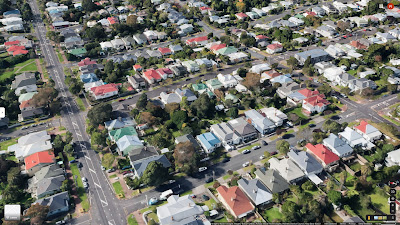
The Wrong Side of my Car
The blog that wants to go obsolete
Is ornamentation really a crime?
1890 — Grey Lynn, Auckland.
Time to build, build, build. There’s a brand new subdivision and there’s money to be made. The streets are laid out, in a neat grid. Except that awkward hole where the swamp is. New houses, mass produced. All of them more or less the same, with their bay windows and porches. Get a load of mass produced widgets to decorate and customise their looks a bit. Tacky, perhaps, but it gets the job done. Nobody wants to live in a landscape that looks like a bunch of cardboard boxes with holes cut out, right?

1910 — Vienna
Adolf Loos is going to give a lecture. He has a beef. Why do we insist on spending resources and labour on decorating buildings? Why should workers keep working on fake pillars and bas-reliefs, if they could just as well call it a day and go home? Those decorations don’t make those houses bigger, or dryer, or warmer, right? Ornament und Verbrechen. Ornament and Crime.
And the rest, as they say, is history. Bauhaus. Le Courbusier, etc. The argument against ornamentation started taking a life on its own *2. It is time for Modernism.
1931 — New York
After 13 and a half months of construction, it is ready. The Empire State building, the world’s tallest building. On time, and on budget. It was A triumph of modern construction techniques. And of course also its architectural style — Art Deco — this Modernism hadn’t quite caught on yet.
1990 — Grey Lynn, Auckland.
All those little villas are still there. Who would have thought, 100 years ago?
The area used to be bit decrepit, but that was the ideal opportunity for young couples to buy one on the cheap and have it renovated. Things are looking up now.
2022 — Auckland
It is Unitary Plan revision time again. (That is basically our zoning code.)
So, time to talk again about this ‘character overlay’ in central Auckland. Its aim is to prevent people from demolishing those old villas so they can build new buildings. Some say this is a bad idea. Making new buildings is really important. But why do they always have to look like a toddler had fun with a cardboard box and a knife? Go ruin someone else’s neighbourhood with your ugly modern buildings.
So, council officers went out, both in person and virtually on Google Streetview, to see which homes were of good character *3. Must preserve what nice looking areas we have, because once lost, we can’t create new ones.
I would love to go back in time, to 1890, and tell those developers that all these houses are still standing, and protected. Not sure if that was the expectation back then.
2022 — Balmoral, Auckland.
On the corner of Balmoral Rd and Henley Street sits an old dairy. Graffiti and weeds adorn its walls. A few years ago the owner decided it was time to build something new.

And a couple of locals are furious. That it would ruin the character of the neighbourhood. Cue a lot of prose about the rhythm of the street and landscape. (Which was, obviously, totally not disrupted by that bright red colour.)
This had been dragging on for years *5.
Wouldn’t people look forward to how the new building is going to look? Almost anything would look better than a building that is on the verge of spontaneous self-demolition, right?
And yet. This held up development for another few months. Eventually it would be approved, on the strict condition she builds houses with wooden window frames. (sic) *6
Ok then, who still makes wooden window frames?
Today — A home improvement shop near you
These shops stock a wide variety of useful things for your home. Kitchenware. Bedding. Furniture. Electrical appliances. Home decor—
Wait, what? Do you mean, entire aisles dedicated to decorations?
Things that cost money, but don’t make your home bigger? Or warmer?
So, why?
Could it be that decoration is, in fact, a function?
Here we are, at the point where it is totally normal to have an almost outright blanket ban on new buildings in entire neighbourhoods. *7 Almost 90% of residential areas in inner Wellington are covered in character protection.
Can you imagine someone declaring that cars built after 1960 are not welcome in your entire neighbourhood? Everyone would automatically think they’re nuts. But with buildings? Totally normal. Why is that?
Will I still end up living through a time when people look forward to new buildings, instead of just tolerating them?
Source: “Part 2 of a 3 part panorama of Mount Eden, Auckland”. Auckland Star :Negatives. Ref: 1/1-002814-G. Alexander Turnbull Library, Wellington, New Zealand. /records/22757790
This did not go unnoticed by Loos, who later published a follow-up, “Ornament und Erziehung”, to clarify that perhaps we should not actively avoid or abolish ornaments, but that didn’t quite get the reach of the original lecture.
This was reported on Greater Auckland. This was a mix of field surveys and looking at Google Streetview. The council published these Findings Reports in case you are wondering if your house made the cut.
You can just about still recognise the ‘Heartbrand’ ice cream logo. The local brand name in New Zealand is ‘Streets’. Dutch Wikipedia has an overview of the brand names used in other countries. (Image from Stuff)
“Disagreement over 'character value' of dilapidated dairy holds up houses” — Stuff.
The owner already tried to have a redevelopment approved in 2020, two years prior. This just shows how difficult it is to get redevelopment approved. This 2 year period probably explains the state of the building. But let’s be honest, even back then it was hardly a Notre Dame, or a Bauhaus.
There was, at the time of writing, a linked article about some new housing not keeping something something front yards. It is too good to not mention it. What a gold mine for NIMBY quotes.
Submitters claiming it would bring “young kids and cars” to the neighbourhood.
So there are certainly more, let’s call it cynical reasons to oppose any and all new development in your local neighbourhoods. But this prevailing idea of new buidings being ugly definitely makes it easier to sell some BS objections to the general public, and to politicians.
This is of course not technically correct. But it seems to work well enough in practice. In central Auckland, blocks and blocks of these old villas still stand, despite the extreme market demand for more housing in the area. And apart from the character overlay, there used to also be a massive area zoned for one single on at least 600 m², which makes any development all but impossible.
There is this development called ‘cohaus’ somewhere in the area, and their story is a good illustration why similar developments are so rare.
Normally, these areas would have grown up in the same way any other area in perimeter block arrangement would have grown up. Even 2 to 4 storeys row houses and small apartments would have allowed 2 or 3 times the current population density.
But no, it is all blocked. This is how we end up with buildings where the land is worth literally 10 times more than the building itself.



Post a Comment